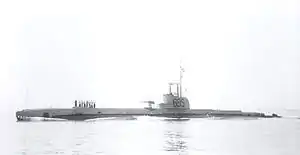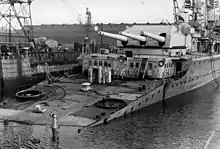HMS Spearfish
HMS Spearfish was a second-batch S-class submarine built during the 1930s for the Royal Navy. Completed in 1936, the boat participated in the Second World War. The submarine was one of the 12 boats named in the song "Twelve Little S-Boats". So far she has been the only ship of the Royal Navy to be named Spearfish.
 Spearfish on the surface | |
| History | |
|---|---|
| Name: | Spearfish |
| Ordered: | 18 February 1935 |
| Builder: | Cammell Laird, Birkenhead |
| Laid down: | 23 May 1935 |
| Launched: | 21 April 1936 |
| Commissioned: | 11 December 1936 |
| Fate: | Sunk, 1 August 1940 |
| Badge: |
 |
| General characteristics | |
| Class and type: | S-class submarine |
| Displacement: |
|
| Length: | 208 ft 8 in (63.6 m) |
| Beam: | 24 ft (7.3 m) |
| Draught: | 11 ft 10 in (3.6 m) |
| Installed power: |
|
| Propulsion: |
|
| Speed: |
|
| Range: | 6,000 nmi (11,000 km; 6,900 mi) at 10 knots (19 km/h; 12 mph) surface; 64 nmi (119 km; 74 mi) at 2 knots (3.7 km/h; 2.3 mph) submerged |
| Test depth: | 300 feet (91.4 m) |
| Complement: | 40 |
| Armament: |
|
Design and description
The second batch of S-class submarines were designed as slightly improved and enlarged versions of the earlier boats of the class and were intended to operate in the North and Baltic Seas.[1] The submarines had a length of 208 feet 8 inches (63.6 m) overall, a beam of 24 feet (7.3 m) and a mean draught of 11 feet 10 inches (3.6 m). They displaced 768 long tons (780 t) on the surface and 960 long tons (980 t) submerged.[2] The S-class submarines had a crew of 40 officers and ratings. They had a diving depth of 300 feet (91.4 m).[3]
For surface running, the boats were powered by two 775-brake-horsepower (578 kW) diesel engines, each driving one propeller shaft. When submerged each propeller was driven by a 650-horsepower (485 kW) electric motor. They could reach 13.75 knots (25.47 km/h; 15.82 mph) on the surface and 10 knots (19 km/h; 12 mph) underwater.[4] On the surface, the second-batch boats had a range of 6,000 nautical miles (11,000 km; 6,900 mi) at 10 knots (19 km/h; 12 mph) and 64 nmi (119 km; 74 mi) at 2 knots (3.7 km/h; 2.3 mph) submerged.[3]
The S-class boats were armed with six 21 inch (533 mm) torpedo tubes in the bow. They carried six reload torpedoes for a total of a dozen torpedoes. They were also armed with a 3-inch (76 mm) deck gun.[2]
Construction and career
Ordered on 18 February 1935, Spearfish was laid down on 23 May 1935 in Cammell Laird's shipyard in Birkenhead and was launched on 21 April 1936. The boat was completed on 11 December 1936.[5]
Her wartime career started inauspiciously, when on 24 September 1939, she was heavily damaged by German warships off Horns Reef. She managed to escape despite being unable to submerge. A rescue mission was undertaken by the British Humber force and Home Fleet, including the aircraft carrier HMS Ark Royal, and the battleship HMS Nelson, which performed escort duty whilst search and rescue attempts were made. The fleet was attacked by Junkers Ju 88 bombers of the Luftwaffe's Kampfgeschwader 30, and a bomb caused slight damage to the battlecruiser HMS Hood. Spearfish safely put in Rosyth on 26 September, and repairs were completed in early March 1940.
Another notable action occurred on 11 April 1940, whilst patrolling in the Kattegat, under the command of Lieutenant Commander John Hay Forbes, she torpedoed and damaged the German heavy cruiser Lützow, putting her out of action for over a year.[6][7] At the time it was reported that she sank her sister ship, Admiral Scheer.[8] Later that year, on 20 May, she sank two Danish fishing vessels S.130 and S.175 with gunfire in the North Sea.[6]
Spearfish sailed from Rosyth on 31 July 1940, still under the command of "Jock" Forbes, to patrol off the Norwegian coast. On 1 August she was spotted on the surface by the German submarine U-34 under the command of Wilhelm Rollmann who attacked and sank her, about 180 miles (290 km) west-southwest of Stavanger.[9] There was only one survivor, Able Seaman William Pester, who was taken about the U-34 as a prisoner of war.[10]
Citations
- Harrison, Chapter 16
- Chesneau, p. 49
- McCartney, p. 6
- Bagnasco, p. 110
- Akermann, p. 334
- "HMS Spearfish (N 69)". uboat.net.
- "Go2War2.nl – Deutschland". go2war2.nl.
- I Was There! – We Knew We Had Hit The 'Scheer', The War Illustrated, 3 May 1940.
- "HMS Spearfish (N 69)". uboat.net. Retrieved 31 July 2012.
- "Losses – National Maritime History – NMH". rnsubmus.co.uk.
References
- Akermann, Paul (2002). Encyclopaedia of British Submarines 1901–1955 (reprint of the 1989 ed.). Penzance, Cornwall: Periscope Publishing. ISBN 1-904381-05-7.
- Bagnasco, Erminio (1977). Submarines of World War Two. Annapolis, Maryland: Naval Institute Press. ISBN 0-87021-962-6.
- Colledge, J. J.; Warlow, Ben (2006) [1969]. Ships of the Royal Navy: The Complete Record of all Fighting Ships of the Royal Navy (Rev. ed.). London: Chatham Publishing. ISBN 978-1-86176-281-8.
- Chesneau, Roger, ed. (1980). Conway's All the World's Fighting Ships 1922–1946. Greenwich, UK: Conway Maritime Press. ISBN 0-85177-146-7.
- Harrison, A. N. (January 1979). "The Development of HM Submarines From Holland No. 1 (1901) to Porpoise (1930) (BR3043)". Submariners Association: Barrow in Furness Branch. Archived from the original on 19 May 2015. Retrieved 19 August 2015.
- McCartney, Innes (2006). British Submarines 1939–1945. New Vanguard. 129. Oxford, UK: Osprey. ISBN 1-84603-007-2.
- Rohwer, Jürgen (2005). Chronology of the War at Sea 1939–1945: The Naval History of World War Two (Revised & Expanded ed.). Annapolis, Maryland: Naval Institute Press. ISBN 1-59114-119-2.
